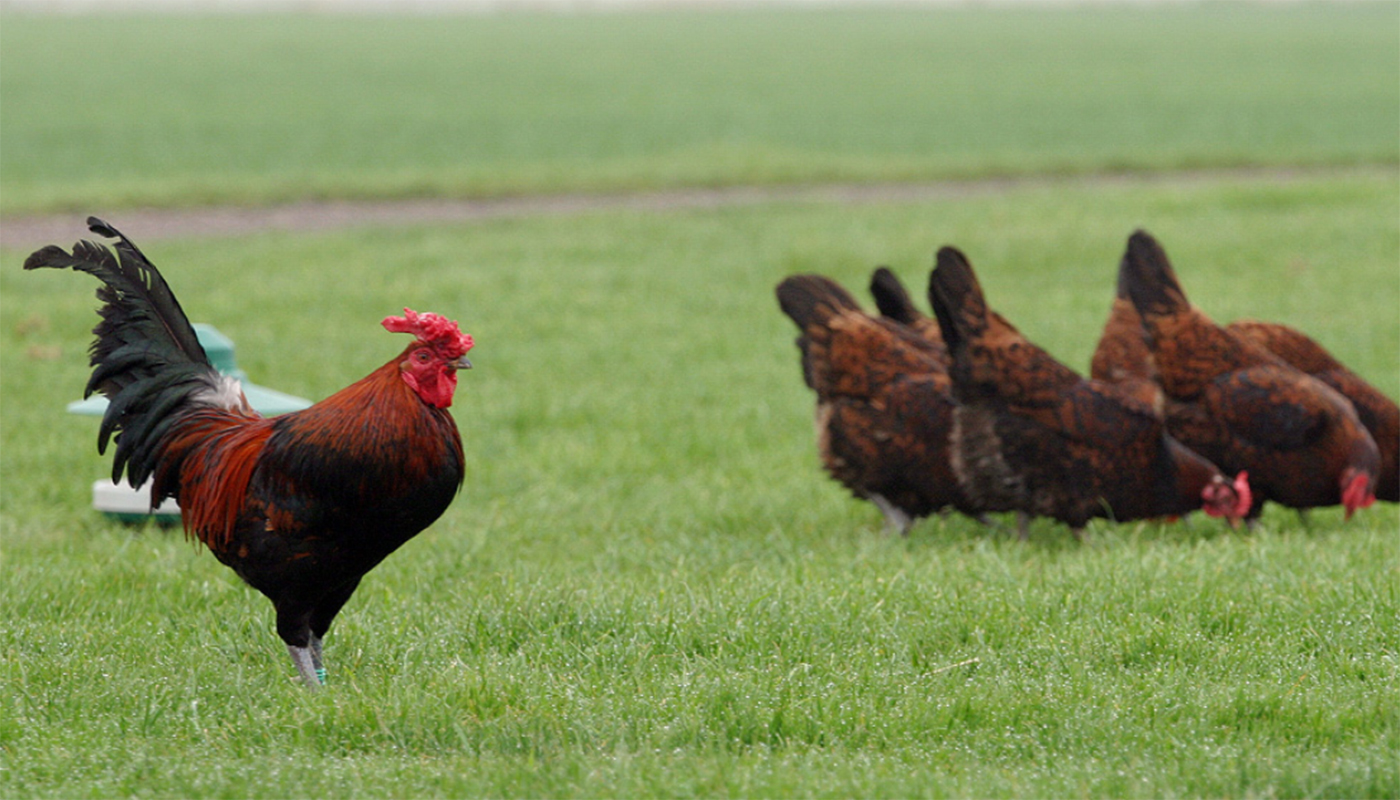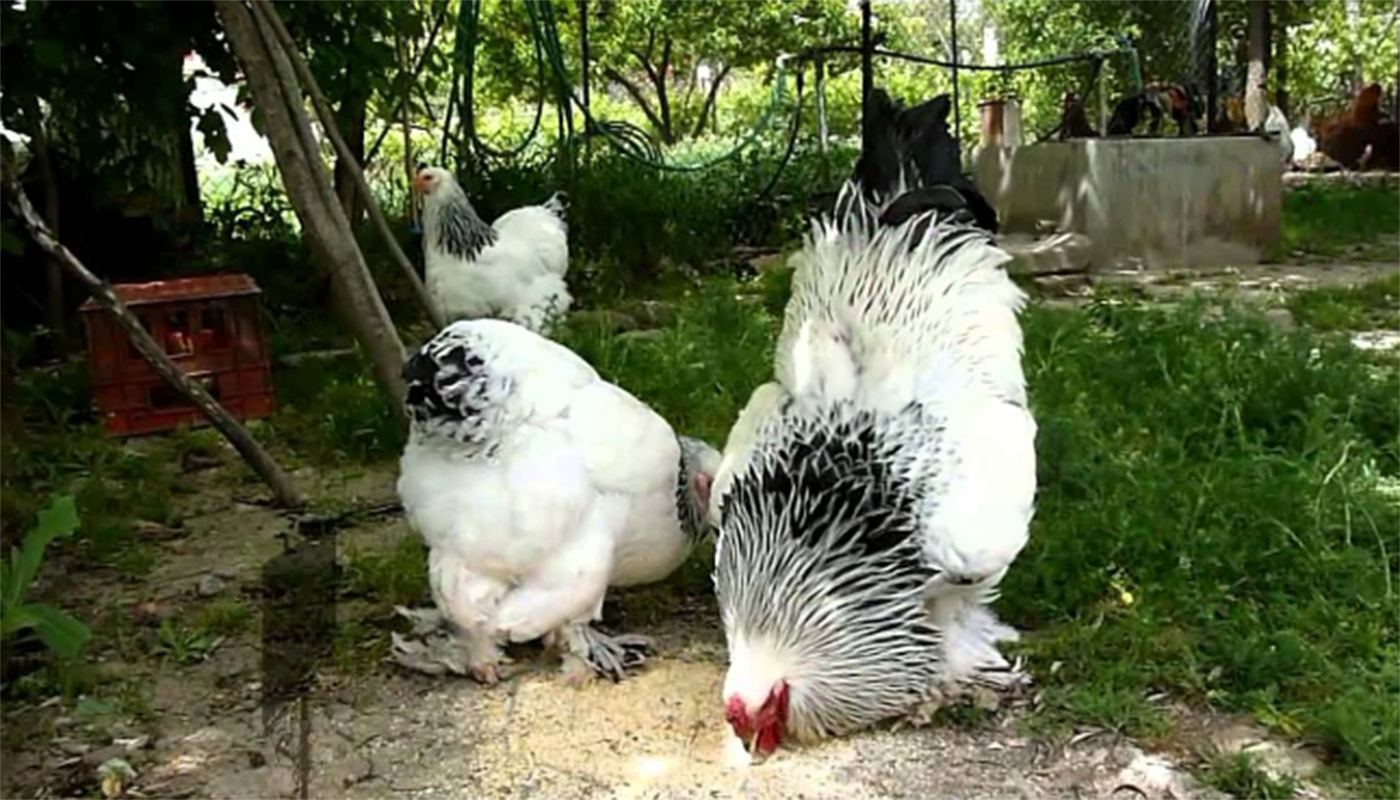
The Rhode Island White although it shares a common place of origin from which they are both named are in fact distinctly different breeds.
The Rhode Island White and Rhode Island Reds are, however, used to create hybrid breeds such as the ISA Brown, when mixed together and or with other chicken breeds. The crossing of the Rhode Island White with the Rhode Island Red also makes “Red Sex-Link” chicks. This means that the hatchlings can be sexed by their color when they hatch. The female chicks are born red in color and the male chicks born white in color.
They are beautiful birds with silky pure white plumage and pretty face of bright red.
They are a fantastic dual-purpose bird that makes for excellent pets and good show birds too.
With an even temperament and their easy adaptability to most any size garden or homestead, they are a great choice for any poultry owner even a complete beginner.
| Country of Origin: | America |
| American Poultry Association: | Yes, they are Recognized as a breed of chicken in the United States Accepted into the Standard of Perfection in 1922 |
| Chicken Category: | Large Breed |
| Chicken Class: | American |
| Bantam Variety Available? | Yes – Rose Comb Clean Legged Bantam Classification |
| Good Starter Chicken? | Yes, their even temperament and low maintenance make them a great starter chicken |
IDENTIFICATION⇒ |
Appearance/Body: As their name implies the Rhode Island Whites are completely white with soft feathering and a solid sturdy body that has been said to be brick-like. They are a medium sized fowl with a large well-rounded head sporting red wattles, earlobes and a medium-sized red comb. Their beaks are yellow, and they have reddish color eyes. They have sturdy clean yellow legs and toes.
Color(s) White
Comb: They have a single comb in the standard breed and a rose comb in the Bantam breed
Ave. Weight: Pullet: 3.8 lbs. Hens: 4 lbs. Cockerel: 5 lbs. Rooster: 5.5 lbs. |
PURPOSE⇒ |
Eggs: They are very egg layers
They lay around 240 – 250 eggs per year They lay medium to large brown eggs. They start to lay eggs from around 22 weeks old.
Meat: They have yellow skin
They were bred partly as a meat bird and are reported to have an excellent quality of meat.
Breeding:They are not too difficult to breed as they hens do get broody and they are really good to pair with the Rhode Island Red
The hens do get broody They are not the best brood hens They will sit their eggs They will raise their chicks and make really good protective mothers. The roosters may also get a bit aggressive and protective over the chicks and hens. They have been known to foster other chickens/breeds chicks
Foraging: They do like to forage about as they happily free range around the garden eating the fresh pickings from the garden
Show Bird: These pure white birds with their rosy cheeks make a good show bird
Pets: Their easy-going nature makes for a great pet
Other: These lovely white chickens will make a great addition to any flock and give loads of nutritious brown eggs. They will also make you proud should you wish to show your bright white chicken.
|
CHARACTERISTICS |
|
|---|---|
| Life Expectancy: | The average lifespan is 8 – 12 years |
| Health: | They have no known health issues |
| Temperament: | Can be shy and the roosters a bit aggressive but they are otherwise quite friendly, calm and quiet birds that are generally easy to handle |
| Flyers? | They can fly but unless really necessary they tend not to |
| Noisy Birds? | They are quite a noisy breed as they love to chat |
| Interaction with other chickens: | They are rather accepting birds that adapt to most other chickens/breeds without a fuss. The roosters may need to be kept apart as they are on the aggressive side. |
| Good with kids? | They are okay with supervised kids |
| Socialize Behavior? | They will shy away from other domestic animals but will mingle once they are acquainted. |
| Known predators: | Although most animals will leave them alone their white plumage makes them an easy target for night predators. It is always best to keep an eye on your cats and dogs. Check with local animal shelters, zoos, vets, animal control and or pet stores about common predators in your area. |
| Conservation Status: | These birds conservation status is recorded as “threatened”. It is best to check on any special license or instructions that may be set up for owning these birds. This can be checked with your local or national conservation centers. |
IDEAL ENVIRONMENT |
|
|---|---|
| Garden Size: | They are adaptable to any garden/homestead size |
| Ideal Climate: | Although they are more cold hardy than heat hardy they can withstand most climates |
| Ideal Coop: | The rule of thumb for any coop is 50 cm x 50 cm per hen/rooster in the coop. Ensure there is a good space for the nesting boxes and nightly roosting rails at least 1.5 inches wide. Good ventilation for air but not too drafty especially in winter. It is always a good idea to raise the coop off the ground to give the birds a dry place to roost and lay especially in wet weather. For Bantam breeds, it is best to have the coop in a protected shed or barn. |
| Ideal Coop Run: | They can fly, and they are white, so it is best to completely cover their coop run to ensure their safety and that they do not fly the coop. |
| Ideal Flock Size: | They are quite happy in any size flock as long as they have some chicken friends to chat and wander around with. |
| Special Instructions: | They have not special requirements |
| Accessories: | The following accessories are ideal for your coop: Nesting boxes Straw for the boxes and roosting area Roosting rails Perches Water troughs/bowls Food bowls/feeders Heating lamp(s) Animal carrier for transport purposes |
| You may Also Like: | 45 FREE DIY CHICKEN COOP PLANS, TUTORIALS AND DESIGNS |
WHERE TO BUY THEM |
|
|---|---|
| Live Poultry Outlets: | You will most likely find these birds at most Live Poultry Outlets. |
| Internet Poultry Websites: | Internet sites such as Purely Poultry and Cackle Hatcheries usually have them for sale. You can check with the various associations and or clubs for more information on reputed poultry outlets and poultry Internet sellers. |
| Organizations: | As they are in the Standard of Perfection the American Poultry Association should have some listed breeders. The American Livestock Conservancy keep various breeder lists and some valuable breed information including their conservancy status and special instructions. |
| Breeders Clubs: | Feather Site has the name of a few reputable breeders of the Rhode Island White. |
| Other: | The organizations and or breeders listed above may also have a host of valuable information about your chickens. They will also be able to provide you with any special instructions, problems, etc. about your chickens. |
HISTORY
The Rhode Island White was developed in 1888 in Rhode Island. Mr J. Alonzo Jocoy developed the Rhode Island White by crossing Rose Comb White Leghorns with Partridge Cochins and White Wyandottes.
By 1903 they were ready to be shown to the public and offered for sale.
Throughout the years the breed continued to be improved upon to ensure that it had the same sturdy structure of the Rhode Island Red to help prevent it from being confused with the either the White Plymouth Rocks or White Wyandottes.
During a national conference in Tennessee by the American Poultry Association in 1922 the Rhode Island White was admitted to the Standard of Perfection.
Although they were quite popular right up until the 1960’s they were never really as popular as the Rhode Island Red. The mid-1960’s saw the breeds numbers start to decline to less than 3000 birds as per the Livestock Conservancy’s 2003 census and there were even fewer in the 2015 poultry census.
These birds deserve more as they are really great egg layers with a study showing one chicken to have laid 306 eggs in one year. The average hen of this breed lays a very productive 240 to 250 eggs per year.
Not only are they really prolific egg layers but their quality and tasty meat make them quite the remarkable dual-purpose bird.
As a pet or backyard coop chicken, you cannot go wrong with these beautiful white ladies as they are intelligent and friendly chickens that easy to handle and low maintenance.
More breeders are required to keep this really dynamic breed going as it is quite a rare chicken to come by in recent years.
NOTES / SPECIAL INSTRUCTIONS
As they are registered as a “threatened” conservation status they may need an extra license to own or keep in your garden. For advice on what the bird’s conservation status and orders are please check with your local conservation department.
For breeders, it is imperative that you always check your bird’s bloodlines and ensure you are buying your birds from a reputed breeder/farm. In order to sell birds of such stature, they have to be recorded and documented, always check with local animal breeding organizations for these records.
These legitimate documents are also required should you wish to show your bird(s) in various poultry shows/competition showings.
For information and advice on adopting rescued animals, you can visit or contact your local animal welfare center.
Video
USEFUL LINKS
- Caring for your Chicken
- Feeding
- Health
- Socializing your Chicken
- Breeding Chicken
- Raising Chickens A-Z
- Hatching Eggs
- What is Molting
- Animal Shelter (ASPCA)
- American Veterinary Medical Association
- American Poultry Association
- American Animal Welfare Society
- American Animal Control
- American Animal Husbandry Society
References
- https://en.wikipedia.org
- https://livestockconservancy.org
- https://www.roysfarm.com
- https://www.mypetchicken.com
- https://www.backyardchickens.com
- https://www.feathersite.com/
 Barnevelder Chicken Breed – Everything You Need to Know
Barnevelder Chicken Breed – Everything You Need to Know Marans Chicken Breed – Everything You Need to Know
Marans Chicken Breed – Everything You Need to Know SOCIALIZING YOUR NEW CHICKENS
SOCIALIZING YOUR NEW CHICKENS Planning and Housing a flock of chickens
Planning and Housing a flock of chickens Houdan Chicken Breed – Everything You Need to Know
Houdan Chicken Breed – Everything You Need to Know Feeding your Chickens
Feeding your Chickens Top 10 Bantam Chicken Breeds for Beginners
Top 10 Bantam Chicken Breeds for Beginners Sultan Chicken Breed – Everything You Need to Know
Sultan Chicken Breed – Everything You Need to Know Redcap Chicken Breed – Everything You Need to Know
Redcap Chicken Breed – Everything You Need to Know Frizzle Chicken Breed – Everything You Need to Know
Frizzle Chicken Breed – Everything You Need to Know 10 Chicken Breeds that do well among other Chicken Breeds for a Mixed Flock
10 Chicken Breeds that do well among other Chicken Breeds for a Mixed Flock Catalana Chicken Breed – Everything You Need to Know
Catalana Chicken Breed – Everything You Need to Know
I’ve just started raising the Rhode Island White this year, 2020; one of the better things to come out of this crazy world. They lay very well and I am glad that I chose them to become the newest member of my farm.